| Resources for the Season of Easter
for liturgy, assemblies and RE teaching |
| Easter |
|
||
Easter is the Christian feast which celebrates the resurrection of Jesus. Eastertide (or the Season of Easter) is the 50 days following Easter and concludes with the Feast of Pentecost. The Council of Nicaea (325ad) determined Easter Day as the first Sunday after the full moon after the spring equinox (19/20/21 March). This is the reason the date of Easter changes from year to year. The earliest it can be is 22nd March and the latest the 25th April. Easter is known as the Pasch in the Latin and Greek Christian traditions - a name which derives from the Hebrew Day of Passover. The origin of the English word 'Easter' is uncertain but it may come from the name of a pagan goddess of the dawn, Eostre. As Christianity spread, it often took over pagan celebrations and replaced them with Christian feast days. |
|||
| The Gospel Account | |||
Mark 16:1-7 (NRSV) When the sabbath was over, Mary Magdalene, and Mary the mother of James, and Salome bought spices, so that they might go and anoint him. And very early on the first day of the week, when the sun had risen, they went to the tomb. They had been saying to one another, ‘Who will roll away the stone for us from the entrance to the tomb?’ When they looked up, they saw that the stone, which was very large, had already been rolled back. As they entered the tomb, they saw a young man, dressed in a white robe, sitting on the right side; and they were alarmed. But he said to them, ‘Do not be alarmed; you are looking for Jesus of Nazareth, who was crucified. He has been raised; he is not here. Look, there is the place they laid him. But go, tell his disciples and Peter that he is going ahead of you to Galilee; there you will see him, just as he told you.’ See also: Mark 16:9-18, Matthew 28:1-8, Luke 24:1-12 and John 20:1-18
|
|||
| The Paschal Candle | |||
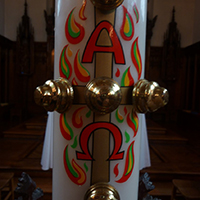 |
The symbols inscribed on the Paschal Candle are the cross of the crucifixion with five incense grains representing the five wounds of Jesus; the Greek letters Alpha and Omega announce that Christ is the beginning and end of all things; the date of Easter is also inscribed (2018). The prayer from the liturgy of the Easter Vigil is as follows: Christ yesterday and today (the vertical line of the cross is cut into the candle) Then the five grains of incense (usually in brass containers with spikes to press into the candle) are put in place: By his holy (first incense grain is inserted at the top of the cross) |
||
 |
The Inscribing of the Paschal Candle An animated powerpoint showing the rite of inscribing of the Paschal Candle from the Jesuit Institute London (updated for 2021) |
||
Easter Candle Prayer This prayer might be used to light the Easter Candle at the beginning of assemblies during Eastertide. God our Father, |
|||
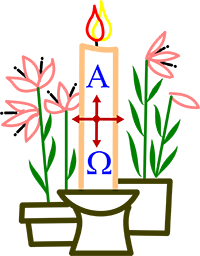 |
Easter Candle with Flowers |
||
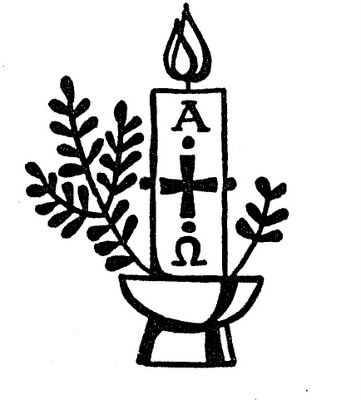 |
Paschal Candle Source unknown |
||
| The Easter Mass for Schools | |||
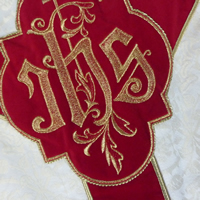 |
Easter is the most important feast in the Church's year and it is important for schools to celebrate Easter at the beginning of the summer term. Elements from the Easter Vigil can be used effectively in a school Easter Mass. You might be able to begin outdoors around a fire and light the Paschal Candle. Or you could use the Liturgy of Light to bless and inscribe the Paschal Candle. Prayers and readings for an Easter Mass (including alternative prayers for use with children): The Easter gospel could be done as a drama (either just with voices or with simple actions): Or you could use the Medieval English drama of the three Marys at the tomb: |
||
| Images | |||
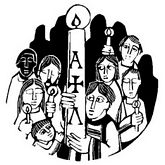 |
The Easter Vigil Source unknown |
||
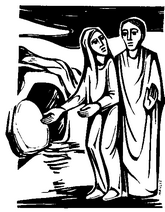 |
Jesus and Mary Magdalene Source unknown |
||
 |
The Stone Rolled Away Source unknown |
||
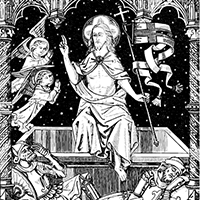 |
Resurrection Source unknown |
||
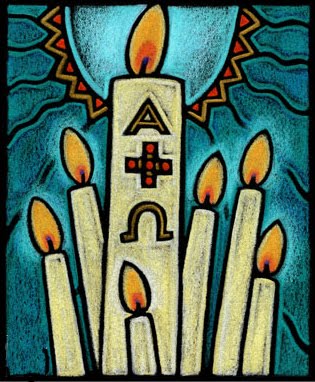 |
Easter Candles Source unknown |
||
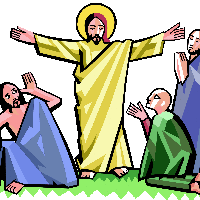 |
The Resurrection Source unknown |
||
| Videos | |||
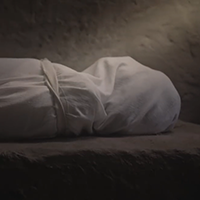 |
He Arose Igniter Media An astonishingly powerful film without words about the events of holy week and the resurrection. |
||
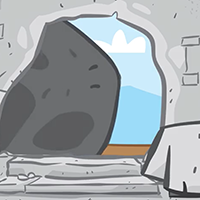 |
The Story of Easter Saddleback Kids A simple and humorous cartoon telling of the Easter story for primary (and lower secondary) age children. |
||
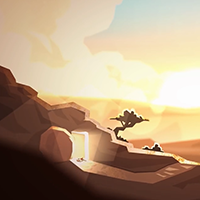 |
Luke Chapter 24 The Bible Project A discussion of Luke's account of the resurrection and post-resurrection appearances. Suitable for secondary age pupils. |
||
 |
He is Risen! The Life of Jesus Christ Bible Videos The story of holy week from the entrance into Jerusalem to the Resurrection appearance to Mary (John 20:11-17) |
||
 |
Jesus is Resurrected The Life of Jesus Christ Bible Videos The events of Easter morning (John 20:3-18). |
||
 |
Easter Story |
||
 |
The Easter Story told through Social Media |
||
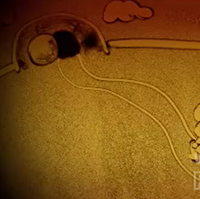 |
The Easter Story told through Sand Animation Worship House Media |
||
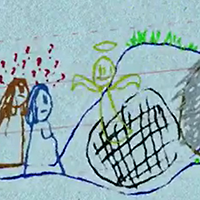 |
Easter Story for Young Children |
||
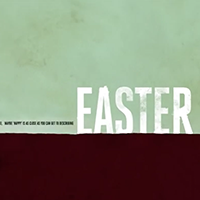 |
Why I Say Happy Easter |
||
| Texts | |||
 |
Easter Verses of the Three Marys |
||
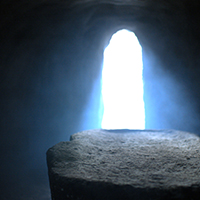 |
An Easter Prayer When everything was dark Your love was too strong, The sparks cast by your love Gracious God: We pray that the Easter light of life, hope and joy, |
||
Easter Faith When our faith |
|||
Blest Are You Who Rose! Blest are you, Lord Jesus who came to us a little child Blest are you, Lord Jesus who came to us as carpenter Blest are you, Lord Jesus who came to us as fisherman Blest are you, Lord Jesus who came to us as teacher Blest are you, Lord Jesus who came to us as healer Blest are you, Lord Jesus who came to us as prophet, Blest are you, Lord Jesus who came to us as servant Blest are you, Lord Jesus, who rose God so loved the world that he gave his only Son |
|||
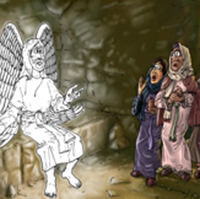 |
Easter Dialogue by Sandy Conway A short drama suitable for secondary school pupils. |
||
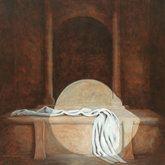 |
Reflection on the Resurrection John Updike's poem Seven Stanzas at Easter (1964) can be used with Sixth Form pupils to reflect on the meaning of resurrection. |
||
| Easter Hymns and Songs | |||
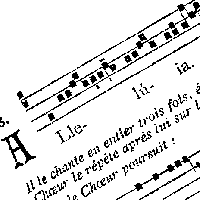 |
Alleluia! Give thanks to the risen Lord (Donald Fishel) Christ, be our light (Bernadette Farrell) ( Christ the Lord is risen today, alleluia! Easter glory fills the skies, alleluia! In Christ alone my hope is found (Thankyou Music) ( Jesus Christ is risen today, alleluia! No more weeping (Christopher Walker) - a 6-part round: great fun to sing! ( Now the green blade riseth ( O Lord my God, when I in awesome wonder Thine be the glory, risen conquering Son This joyful Eastertide ( |
||
| Art and Scripture | |||
Art can be a good way to engage with the resurrection appearances of Jesus. A google search will show thousands of images which could be used. The images below have been chosen because they are unusual. A way of using these resources might be:
Art and Scripture could be used at assemblies, or as the gospel/homily at Mass, or in RE lessons. |
|||
He is not here. He has risen. On the first day of the week, at the first sign of dawn, they went to the tomb with the spices they had prepared. They found that the stone had been rolled away from the tomb, but on entering discovered that the body of the Lord Jesus was not there. As they stood there not knowing what to think, two men in brilliant clothes suddenly appeared at their side. Terrified, the women lowered their eyes. But the two men said to them, 'Why look among the dead for someone who is alive? He is not here; he has risen. Remember what he told you when he was still in Galilee: that the Son of Man had to be handed over into the power of sinful men and be crucified, and rise again on the third day?' And they remembered his words. When the women returned from the tomb they told all this to the Eleven and to all the others. The women were Mary of Magdala, Joanna, and Mary the mother of James.
|
|||
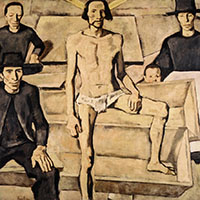 |
Three Days Afterwards You must have heard about the recent happenings in Judaea; about Jesus of Nazareth and how he began in Galilee, after John had been preaching baptism. God had anointed him with the Holy Spirit and with power, and because God was with him, Jesus went about doing good and curing all who had fallen into the power of the devil. Now I, and those with me, can witness to everything he did throughout the countryside of Judaea and in Jerusalem itself: and also to the fact that they killed him by hanging him on a tree, yet three days afterwards God raised him to life and allowed him to be seen, not by the whole people but only by certain witnesses God had chosen beforehand. Now we are those witnesses - we have eaten and drunk with him after his resurrection from the dead - and he has ordered us to proclaim this to his people and to tell them that God has appointed him to judge everyone, alive or dead. It is to him that all the prophets bear this witness: that all who believe in Jesus will have their sins forgiven through his name. Image Christi Auferstehung [Christ's Resurrection] (1924) by Albin Egger-Lienz (1868-1926), an Austrian painter. Talking Points Notice how strong the image of the risen Christ is - he is no ghost or spirit, but a strong, young man, who dominates the painting, and who places his foot firmly on the coffin, triumphing over death. Look at the witnesses. Who are they? What have they seen? What do they believe? Why is there a small child in the painting? |
||
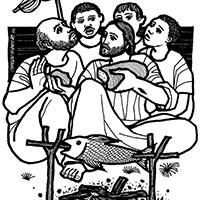 |
Breakfast on the Shore of Lake Tiberias Later on, Jesus showed himself again to the disciples. It was by the Sea of Tiberias, and it happened like this: Simon Peter, Thomas called the Twin, Nathanael from Cana in Galilee, the sons of Zebedee and two more of his disciples were together. Simon Peter said, 'I'm going fishing'. They replied, 'We'll come with you'. They went out and got into the boat but caught nothing that night. It was light by now and there stood Jesus on the shore, though the disciples did not realise that it was Jesus. Jesus called out, 'Have you caught anything, friends?' And when they answered, 'No', he said, 'Throw the net out to starboard and you'll find something'. So they dropped the net, and there were so many fish that they could not haul it in. The disciple Jesus loved said to Peter, 'It is the Lord'. At these words 'It is the Lord', Simon Peter, who had practically nothing on, wrapped his cloak round him and jumped into the water. The other disciples came on in the boat, towing the net and the fish; they were only about a hundred yards from land. As soon as they came ashore they saw that there was some bread there, and a charcoal fire with fish cooking on it. Jesus said, 'Bring some of the fish you have just caught'. Simon Peter went aboard and dragged the net to the shore, full of big fish, one hundred and fifty-three of them; and in spite of there being so many the net was not broken. Jesus said to them, 'Come and have breakfast'. None of the disciples was bold enough to ask, 'Who are you?'; they knew quite well it was the Lord. Jesus then stepped forward, took the bread and gave it to them, and the same with the fish. This was the third time that Jesus showed himself to the disciples after rising from the dead. Image Talking Points Notice how closely the disciples are gathered around Jesus - I wonder why? Notice the boat and the fish - as soon as Jesus died they went back to their original occupations. Did they think Jesus' mission was over? Why do you think Peter recognized Jesus - Had he done this before? (cf. Luke 5:4-11) Why do you think Jesus broke and shared the bread with them? |
||
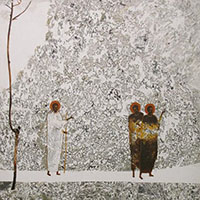 |
The Road to Emmaus That very same day, two of them were on their way to a village called Emmaus, seven miles from Jerusalem, and they were talking together about all that had happened. Now as they talked this over, Jesus himself came up and walked by their side; but something prevented them from recognising him. He said to them, 'What matters are you discussing as you walk along?' They stopped short, their faces downcast. Then one of them, called Cleopas, answered him, 'You must be the only is person staying in Jerusalem who does not know the things that have been happening there these last few days'. 'What things?' he asked. 'All about Jesus of Nazareth' they answered 'who proved he was a great prophet by the things he said and did in the sight of God and of the whole people; and how our chief priests and our leaders handed him over to be sentenced to death, and had him crucified. Our own hope had been that he would be the one to set Israel free. And this is not all: two whole days have gone by since it all happened; and some women from our group have astounded us: they went to the tomb in the early morning, and when they did not find the body, they came back to tell us they had seen a vision of angels who declared he was alive. Some of our friends went to the tomb and found everything exactly as the women had reported, but of him they saw nothing.' Then he said to them, 'You foolish men! So slow to believe the full message of the prophets! Was it not ordained that the Christ should suffer and so enter into his glory?' Then, starting with Moses and going through all the prophets, he explained to them the passages throughout the scriptures that were about himself. When they drew near to the village to which they were going, he made as if to go on; but they pressed him to stay with them. 'It is nearly evening' they said 'and the day is almost over.' So he went in to stay with them. Now while he was with them at table, he took the bread and said the blessing; then he broke it and handed it to them. And their eyes were opened and they recognised him; but he had vanished from their sight. Then they said to each other, 'Did not our hearts burn within us as he talked to us on the road and explained the scriptures to us?' They set out that instant and returned to Jerusalem. There they found the Eleven assembled together with their companions, who said to them, 'Yes, it is true. The Lord has risen and has appeared to Simon.' Then they told their story of what had happened on the road and how they had recognised him at the breaking of bread. Image Source unknown Talking Points Notice how busy the background of this picture is - just like all the conflicting thoughts going through the minds of the two disciples. Notice the tree to the left - perhaps the tree of the crucifixion? Notice the way the path widens at the right - Jesus and the disciples were going different ways but they persuaded him to stay. Notice the use of gold across the chests of the disciples - did not their hearts burn within them as they listened? |
More Images
|
|
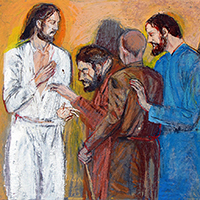 |
Doubting Thomas In the evening of that same day, the first day of the week, the doors were closed in the room where the disciples were, for fear of the Jews. Jesus came and stood among them. He said to them, 'Peace be with you', and showed them his hands and his side. The disciples were filled with joy when they saw the Lord, and he said to them again, 'Peace be with you. 'As the Father sent me, so am I sending you.' Thomas, called the Twin, who was one of the Twelve, was not with them when Jesus came. When the disciples said, 'We have seen the Lord', he answered, 'Unless I see the holes that the nails made in his hands and can put my finger into the holes they made, and unless I can put my hand into his side, I refuse to believe'. Eight days later the disciples were in the house again and Thomas was with them. The doors were closed, but Jesus came in and stood among them. 'Peace be with you' he said. Then he spoke to Thomas, 'Put your finger here; look, here are my hands. Give me your hand; put it into my side. Doubt no longer but believe.' Thomas replied, 'My Lord and my God!' Jesus said to him: 'You believe because you can see me. Happy are those who have not seen and yet believe.' There were many other signs that Jesus worked and the disciples saw, but they are not recorded in this book. These are recorded so that you may believe that Jesus is the Christ, the Son of God, and that believing this you may have life through his name. Image Doubting Thomas by Ivan Valtchev (b.1944) Talking Points Look at the expression and the intensity on Thomas' face - what is he thinking? Who are the other people in the painting? Who is the woman? Who is the mysterious shadow figure in the background? Look at Jesus' hands. What do those gestures mean? |
More Images |
|
| Other Resources | |||
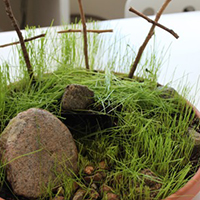 |
Easter Garden Here is an idea for children to create miniature Easter gardens. (Quick grow grass seed is available from B&Q) |
||
 |
Easter Story Wreath An activity for primary age children which connects up the story of Jesus. With printable resources. |
||
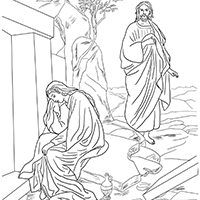 |
Colouring Pages on the Resurrection from colorpages7.com A variety of free colouring pages on the resurrection story for primary age children. |
||
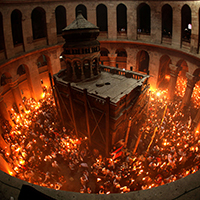 |
Site of the Holy Sepulchre
|
||
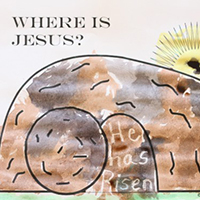 |
He Has Risen! A simple activity for younger children. Write the words "He has risen!" in white oil crayon on the colouring-in sheet and then get the chidren to paint the picture in water colours. The words magically appear and can be used to lead into a discussion of the resurrection. |
||
